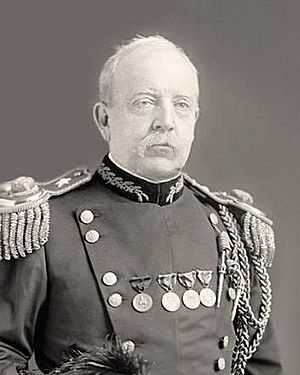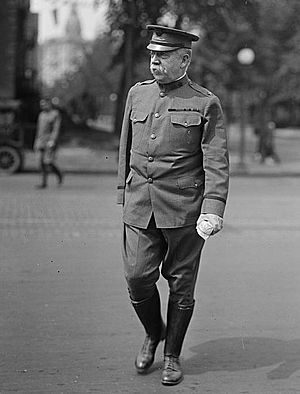William Abram Mann facts for kids
Quick facts for kids
William Abram Mann
|
|
|---|---|

Mann circa 1916, at about the time of his assignment as commandant of the School of Musketry
|
|
| Born | July 31, 1854 Altoona, Pennsylvania |
| Died | October 8, 1934 (aged 80) Washington, D.C. |
| Place of burial | |
| Allegiance | |
| Service/ |
|
| Years of service | 1875–1918 |
| Rank | |
| Commands held | 6th Infantry Regiment Department of Dakota Recruit Depot, Jefferson Barracks, Missouri 3rd Infantry Regiment 1st Brigade, Department of the East 2nd Cavalry Brigade School of Musketry and Field Artillery Militia Bureau 42nd Division Department of the East |
| Battles/wars | American Indian Wars Spanish–American War Pancho Villa Expedition World War I |
| Awards | Silver Star |
| Other work | Executive, Equitable Trust Company of New York |
William Abram Mann (born July 31, 1854 – died October 8, 1934) was an important general officer in the United States Army. He led the 17th Infantry Brigade during the Spanish–American War. Later, he commanded the famous 42nd Division, also known as "The Rainbow Division," in World War I.
After he retired from the military, he worked as an executive at a bank called the Equitable Trust Company of New York. He lived in Washington, D.C. until he passed away on October 8, 1934.
A troop transport ship from World War II was named after him. This ship, the USS W. A. Mann (AP-112), started service in 1943. It was used in World War II, the Korean War, and the Vietnam War.
| Top - 0-9 A B C D E F G H I J K L M N O P Q R S T U V W X Y Z |
Becoming a Soldier: Early Life and Military Career
William A. Mann was born on July 31, 1854, in Altoona, Pennsylvania. His father, Charles J. Mann, was a lawyer and a judge. Charles also served as the mayor of Altoona for a few years.
William went to school in Altoona. He then got the chance to attend the United States Military Academy, also known as West Point. This is a special college for training army officers. He graduated in 1875 and became a second lieutenant in the Infantry.
In the 1870s and 1880s, he served in the western United States. He spent most of his time with the 7th Cavalry Regiment. He also took part in the Sioux Indian campaign from 1890 to 1891 as part of the 17th Infantry Regiment.
Fighting in the Spanish–American War
Mann continued to serve with the 17th Infantry Regiment during the Spanish–American War. He was involved in important battles like the Battle of El Caney and the Siege of Santiago. For his bravery at El Caney, he was awarded the Silver Star.
After this war, Mann also served in the Philippines around 1899 and the early 1900s. He continued his military education and graduated from the United States Army War College in 1905.
After the Spanish–American War
From 1907 to 1909, Mann commanded the 6th Infantry Regiment in Fort William Henry Harrison, Montana. He also sometimes led the Department of Dakota. From 1910 to 1911, he was in charge of the Recruit Depot at Jefferson Barracks in Missouri.
In 1911, he joined the Army's General Staff, which helps plan military operations. From 1912 to 1913, he was the Chief of Staff for the Eastern Department in New York City. He then served as Chief of Staff for a division in Texas City, Texas, from 1913 to 1914.
From 1914 to 1915, Mann commanded the 3rd Infantry Regiment at Madison Barracks, New York. In 1915, he became the commander of the 1st Brigade, Department of the East, in Albany, New York. At this time, he was promoted to brigadier general.
In 1916, General Mann took command of the 2nd Cavalry Brigade in Texas. This was during the Pancho Villa Expedition. Later, he took charge of the School of Musketry and Field Artillery at Fort Sill, Oklahoma.
In 1917, he was chosen to lead the Army's Militia Bureau, which is now called the National Guard Bureau. He was promoted to major general.
Leading in World War I
In 1917, General Mann left the Militia Bureau to help create and train a new division for fighting overseas. He became the first commander of the 42nd Division. This division was nicknamed the "Rainbow Division" because it brought together National Guard units from 26 different states and the District of Columbia.
The creation of the 42nd Division was a big step for the National Guard. It was the first time Guard units from many states were organized into one large division. It also marked the first time smaller Guard units were combined to form a full division.
In November 1917, the division moved to St. Nazaire, France. General Mann was close to his mandatory retirement age. After the division moved to Vaucouleurs in Lorraine, France, he began to experience health problems. Because of this, his chief of staff, Colonel Douglas MacArthur, took on many of his duties. General John J. Pershing, Mann's superior, visited the division and saw that Mann was not well. He then asked the War Department to replace Mann. General Mann returned to the United States and commanded the Department of the East until he retired in July 1918.
Life After the Military
After leaving the military, General Mann became an executive at the Equitable Trust Company of New York.
Retirement and Passing
In his retirement, General Mann lived in Washington, D.C.. He passed away there on October 8, 1934. He was buried at Arlington National Cemetery, a special cemetery for military heroes. His grave is in Section 3, Site 1996.
Family Life
On September 10, 1884, William Mann married Elsie Moir (1862-1936) from Elora, Ontario. They were married until his death and did not have any children.
Awards and Honors
General Mann received several important awards for his service:
- Distinguished Service Medal
- Silver Star
- Indian Campaign Medal
- Spanish Campaign Medal
- Mexican Border Service Medal
- World War I Victory Medal
Legacy: A Ship Named in His Honor
A World War II troop transport ship was named the USS General W. A. Mann (AP-112) in his honor. This ship, the General Mann, began service in 1943. It was used in World War II, the Korean War, and the Vietnam War. The ship remained in service until 1965.
Images for kids
See also
 In Spanish: William Abram Mann para niños
In Spanish: William Abram Mann para niños




